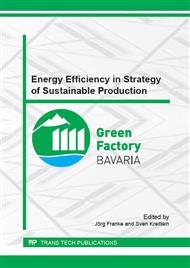p.67
p.73
p.79
p.86
p.94
p.105
p.115
p.123
p.131
E|Flow - From Production Line Concept to a Physically and Digitally Full-Meshed Production Network
Abstract:
The continuous change of the consumers’ behavior combined with the impact of new technologies to the shop-floor is a challenge for the classic and established line production. Due to the effects of mass-customization there is an increase of the variants of the products combined with a reduction of the number of units per variation. Therefore, it is necessary that the next generations of production lines, especially the assembling devices, have to be designed more adaptable. Regarding to business information systems this trend is realized by a progressive digital integration of the particular units. However, at the physical level of the value stream the sequenced units are linked to each other and arranged flow-orientated since Taylor. Particularly, for mass production the so called “line concept” is well established. This inflexibility of the physical material flow blocks the spread of mass-customization into established industrial sectors where linked manufacturing steps are common use. A product which is very individualized is not, or only with an additional expense, producible on such linked lines. Therefore, it is necessary to resolve the linking of the physical material flow similar to the digital integration of the work flow. The result will be a physically and digitally full-meshed network of production units with a high variability. Especially for a production of goods with a high variant diversity the benefits of a physically meshed production site are obvious. Each part gets its own and individual routing, which depends on the current machine availability, the set-up and other factors. Furthermore, a change of the general conditions during the manufacturing of the part can be considered and lead to an adaption of the routing. One of the most important parts of a flexible physical production network is the transport system, consisting of autonomous and smart entities which are interconnected with business information systems, products and machines.
Info:
Periodical:
Pages:
94-101
Citation:
Online since:
November 2015
Authors:
Price:
Сopyright:
© 2015 Trans Tech Publications Ltd. All Rights Reserved
Share:
Citation:


